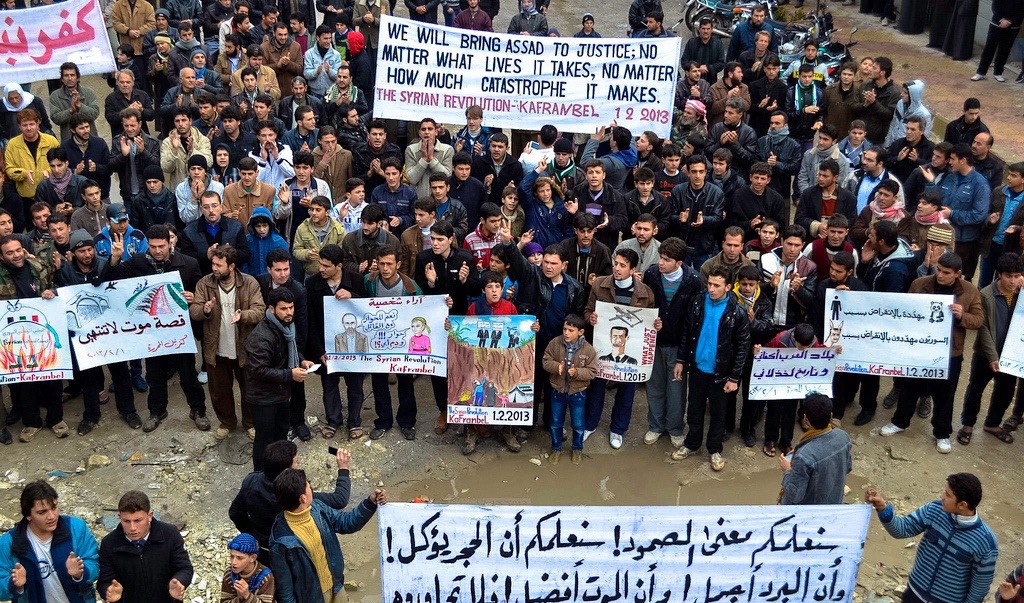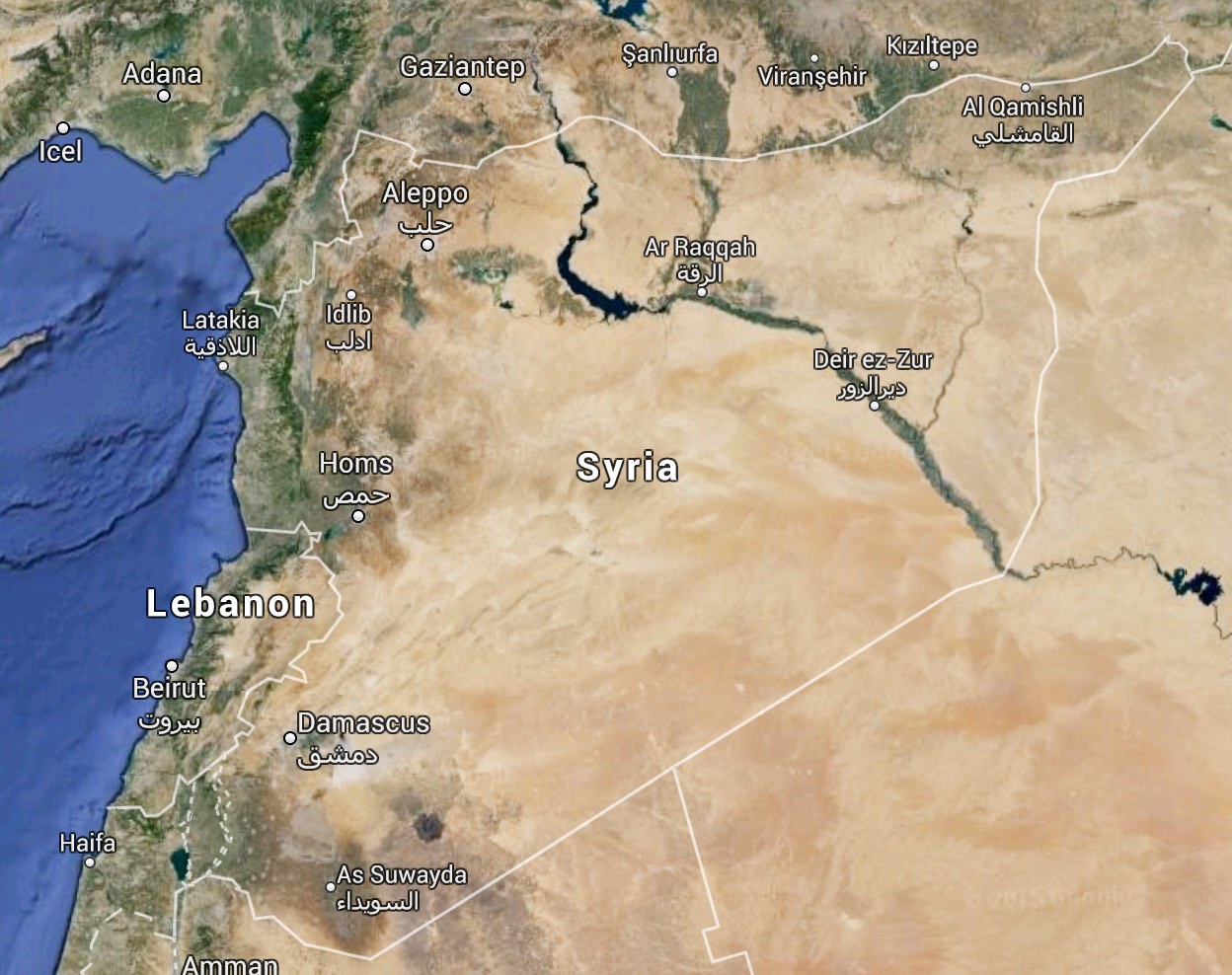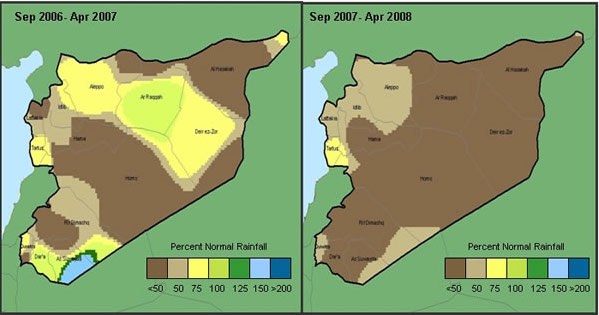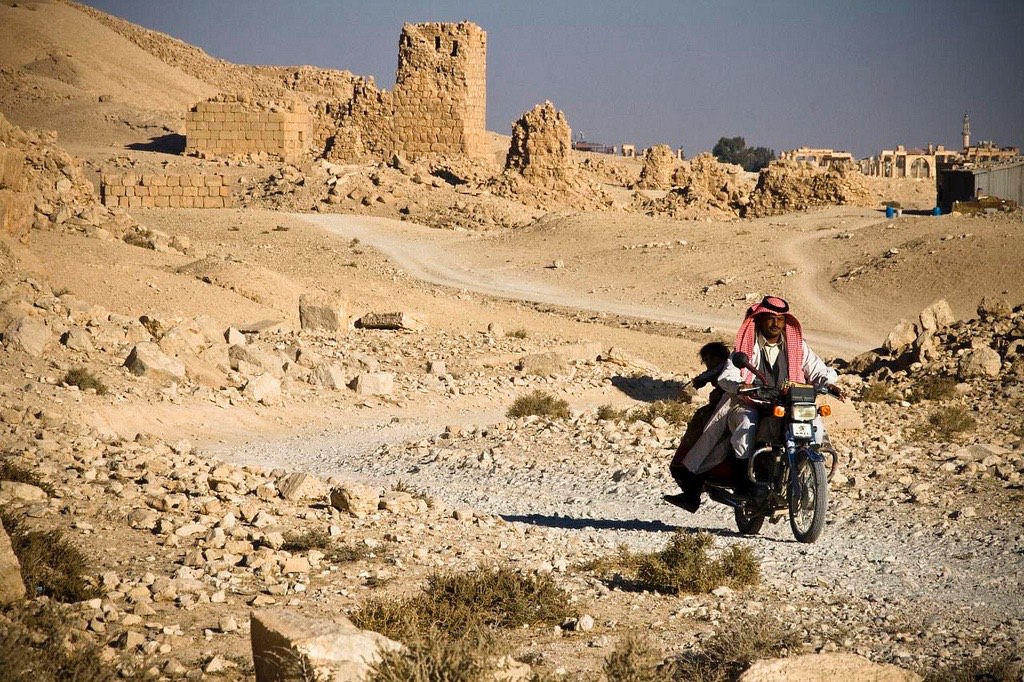Climate Change
1.3 The Effects of Climate Change on the Syrian Uprising
Levi J. Cramer
The Middle Eastern country of Syria has been in a state of civil war since 2011. One factor influencing the current situation is climate change. Climate change is responsible for desertification in the region, which is leading to increased dissent among the citizens of Syria.
Since March of 2011, a small Middle Eastern country named Syria (Figure 2) has been combating an uprising that has been a central focus of international news to this day. The people are rebelling because they are upset with the regime of Bashar al-Assad, the president of Syria (Figure 1). More than seventy-five thousand people have been killed since the inception of the uprising. Casualties have come from citizens either defending the country, or rebelling against it. To understand the frustrations of the Syrian people, one needs to look to the root cause of the uprising.

Photograph by Freedom House, 2013. CC BY 2.0.
There are many reasons for the conflict in Syria. First, the people were upset that the Assad regime refused to yield any of its power and hold a democratic election. Second, the Assad regime was arresting large sums of people for protesting against its rule, including school children. The third and often overlooked reason for the conflict is that climate change has caused large losses for the Syrian agricultural industry, and the government was unwilling to help. Climate change is occurring in Syria by means of depleting water supply and advancing desertification, both of which are closely linked. These effects of climate change are expected to continue through 2050.

Map data ©2015 Google. Public Domain.
Click Here to Explore Damascus, Syria in Google Maps
The Figeh Spring is an important source of water for Syria and is located near its capital city Damascus.1 Researchers found that between 1961 and 1990, precipitation during the winter had dropped by approximately 11%, and by approximately 8% during the spring.1 This drop in precipitation is expected to continue, and between 2070 and 2099 the rate will likely be 22%, with an annual mean temperature increase of 4°C.1 Syria is not the only country in the region experiencing a decrease in precipitation, however its decrease is the largest.2 Between 2007 and 2008, precipitation dropped by 50% in some areas of the country (Figure 3). This is troubling because the region is dependent on precipitation to provide the water needed to grow food. The loss of precipitation becomes dire when run-off from countries north of Syria is also down. Substantial changes in the regional climate are likely to increase the challenges placed on the physical and biological components of riverine ecosystems.3

Courtesy of the USDA Foreign Agricultural Service, 2008. Public Domain.
The decrease in precipitation has also triggered lasting droughts.4 The effects of drought and desertification are further conflated considering that the population of Syria has increased by 50% in the past few years. Increased land use is needed to support this growing population, which contributes to erosion and makes much of the land unusable.5
Desertification is directly correlated with the decrease in precipitation. Since the 1940’s, desertification has been increasing in Syria. Desertification is also affecting regions such as the Khabur River in northeastern Syria. The Khabur River is on the opposite side of the country from Damascus, demonstrating the widespread effects of desertification.6

Photograph by Marc Veraart, 2010. CC BY-ND 2.0.
How do the effects of climate change contribute to the insurrection that is occurring? Droughts are making crops more difficult to grow and causing food prices to rise dramatically. Rise in food prices is leading to impoverished people going hungry, fueling the uprising against the Bashar al-Assad government, and adding to the numbers of refuges and rebels.7 Tragically, the drought has impacted more than 1.3 million people and 160 villages had to be abandoned due to crop failure.8 There has also been a loss of 85% of the livestock.8 These displaced people migrated to the major cities in Syria, including Damascus, and were quickly inundated by rebel propaganda. This propaganda added to the already high levels of dissent that farmers felt for the Assad government. Fueling this preexistent hatred, the farmers subsequently joined the rebels.9
Climate change has led to the increasing number of rebels in Syria. The Syrian crisis is an issue that must be addressed through international systems, as the effects of climate change are likely to increase. Analysts are in agreement that the current effects of climate change in the Middle East are alarming. Nine of the world’s top importers of grain are located in North Africa and the Middle East, and expanding desertification will make growing crops increasingly more difficult.10 The uprising in Syria may be first of many conflicts to arise in the Middle East as a result of climate change.
References
- Smiatek, G., et. al. (2013). Hydrological Climate Change Impact Analysis for the Figeh Spring near Damascus, Syria. Journal Of Hydrometeorology, 14:577-593
- Terink, W., et. al. (2013). Climate change projections of precipitation and reference evapotranspiration for the Middle East and Northern Africa until 2050. International Journal Of Climatology, 33:3055-3072
- Bozkurt, D. & Sen, O.L. (2013). Climate change impacts in the Euphrates-Tigris Basin based on different model and scenario simulations. Journal of Hydrology, 480:149-161
- Kaniewski, D., et. al. (2012). Drought is a recurring challenge in the Middle East. Proceedings Of The National Academy Of Sciences Of The United States Of America, 109:3862-3867
- Haktanir, K., et. al. (2004). The prospects of the impact of desertification on Turkey, Lebanon, Syria and Iraq. Environmental Challenges In The Mediterranean 2000-2050, 37:139-154
- Hole, F. (2009). Drivers of Unsustainable Land Use in the Semi-Arid Khabur River Basin, Syria. Geographical Research, 47:4-14
- Abrams, L. (2013 September 10). How climate change is linked to Syria’s war. Salon, Webpage
- Shank, M. & Wirzba, E. (2013 September 13). How Climate Change Sparked the Crisis in Syria. USNews, Webpage
- Ghose, T. (2013 December 10). Human-Caused Climate Change May Have Worsened Syrian Unrest. Live Science, Webpage
- Plumer, B. (2013 September 10). Drought helped cause Syria’s war. Will climate change bring more like it? The Washington Post, Webpage.
- Freedom House. (2013). Demonstration against ASSad regime in Kafranbel, Idlib. [Photograph]. Retrieved from FlickrCommons. CC BY 2.0.
- USDA Foreign Agricultural Service. (2008). [Diagram of seasonal rainfall in Syria during the 06-07 and 07-08 planting seasons]. Public Domain.
- Veraart, Marc. (2010). [Photograph of man on a motorcycle in the Syrian desert]. Retrieved from FlickrCommons. CC BY-ND 2.0.
